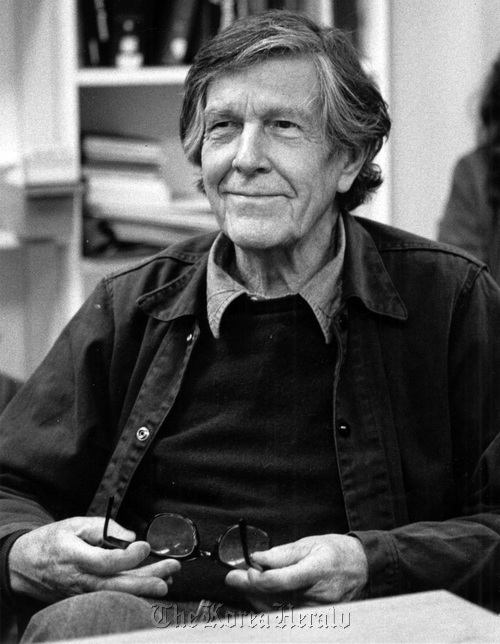LOS ANGELES ― Once, when asked how he thought history would consider his work, John Cage responded that he had made so much, getting rid of it all would be very difficult. Twenty years after his death he has been spectacularly proven right. This year marked the 100th anniversary of the composer’s birth in Los Angeles on Sept. 5. As part of an international celebration, Cage’s work appeared and continues to appear in concert halls, opera houses, museums, galleries, clubs, alternative spaces, reconverted industrial buildings, parks, street corners, atria and even a dock or two by the bay.
Cage literature is adding a groaning shelf-worth of material. No media remained untouched. New releases keep appearing on vinyl (both at 331/3 and 45 rpm!), CD, DVD and Blu-ray. A spare 100-gigabyte hard drive would be handy for all the new Cage downloads. Cage apps and e-books are a growth industry.

Cage conferences were held on the Canadian island of Victoria, at the Sorbonne in Paris, in Moscow, in the Polish town of Lublin and many more places. Germany went Cage crazy. The Chinese got on the bandwagon. European radio stations became fixated on the American composer. Colleges in five continents added Cage courses to their curricula.
The art world has been going gung-ho with exhibitions aplenty. Cage’s profound influence on poetics, philosophy and aesthetics gets endlessly debated. So too does his sexuality (gay or bi?) and whether his so-called silent piece from 1952, “4’33,” in which no intentional sounds are made by a performer, was really a silent cri de coeur of the closet and/or a comment on the stifling atmosphere of the McCarthy era.
No day in 2012 has likely been Cage-free. Something was happening somewhere. Still is, for that matter.
But does this mean that this most radical major composer of the 20th century, who challenged the status quo in nearly every activity he participated in, who expanded the definition of music to include all sounds and all silences, has finally gotten co-opted by the establishment? Has a gorge been carved to permit him entry into the mainstream? Cage always said we could solve art’s and the world’s problems simply by changing our minds. Have we?
Of course not. The work remains radical, shock-worthy even. The music can still empty an auditorium. Cage was often misunderstood. He still can be. The year brought inspired tributes and deep new understanding to Cage and by extension insight into the way the world works. It also brought tomfoolery. And no doubt to the comfort of traditional audiences and performers alike, most of the major classical music institutions, particularly in this country, went right on ignoring Cage as they always have.
Neither the New York Philharmonic nor the Boston Symphony, the orchestras with which Cage was most closely (if never contentedly) associated, played a single note of the composer’s music in 2012. The Philadelphia Orchestra hasn’t exactly jumped on the bandwagon, despite the large Cage festival taking place in its city in conjunction with a major Cage exhibition at the Philadelphia Museum of Art. The Kennedy Center steered clear of Cage during a weeklong Washington Cage centennial festival. No, the U.S. Postal Service didn’t bother to commemorate one of the most influential ― and proudly American ― artists in our history.
Even official Los Angeles willfully twisted its gaze elsewhere from its celebrated native son. Rather than, say, proclaiming Sept. 5 John Cage Day, the county of Los Angeles instead picked that day to extend its official gratitude to Placido Domingo for his service to Los Angeles Opera.
The presentation was at the Music Center, a few blocks away from Good Samaritan Hospital, where John Cage had been born exactly 100 years earlier. Unlike, say, the Staatsoper Berlin, which mounted Cage’s ”Europeras 3 and 4“ (with the great bass Rene Pape included in the cast), the only centennial L.A. Opera observed this year was that of the British composer Benjamin Britten.
But Cage’s influence was unmistakable in opera as it was in many genres of modern music. Two days after Cage’s birthday, for instance, Long Beach Opera presented the U.S. premiere of “The Paper Nautilus” by Gavin Bryars, a British Cage acolyte who around the same time produced a superb radio documentary about his relationship to Cage for the BBC in London.
Still, there was Cage galore. Los Angeles had two eager and illuminating Cage festivals hosted by Southwest Chamber Music in Pasadena and downtown L.A., and another by Jacaranda in Santa Monica. The Los Angeles Philharmonic was one of only two major American orchestras to perform Cage this season (the San Francisco Symphony was the other) ― the La Jolla Symphony and in New York the American Symphony and the S.E.M. Ensemble helped fill in the gaps.
But maybe that was all as it should be. My experience of the Cage year was that, with pointed exceptions, institutional Cage was, for the most part, the most conventional and thus un-Cagean.
This was especially true in the art world, where the tendency among curators was to connect Cage with his art-world predecessors (most notably Marcel Duchamp) and successors (most notably Robert Rauschenberg and Jasper Johns), which is hardly revelatory and often fell, as in Philadelphia, into a deadening masterpiece syndrome.
By Mark Swed
(Los Angeles Times)
(MCT Information Services)
-
Articles by Korea Herald










![[Bridge to Africa] S. Korea-to-Zimbabwe value chains can foster ‘win-win’ cooperation](http://res.heraldm.com/phpwas/restmb_idxmake.php?idx=644&simg=/content/image/2024/05/14/20240514050881_0.jpg&u=20240515223025)








